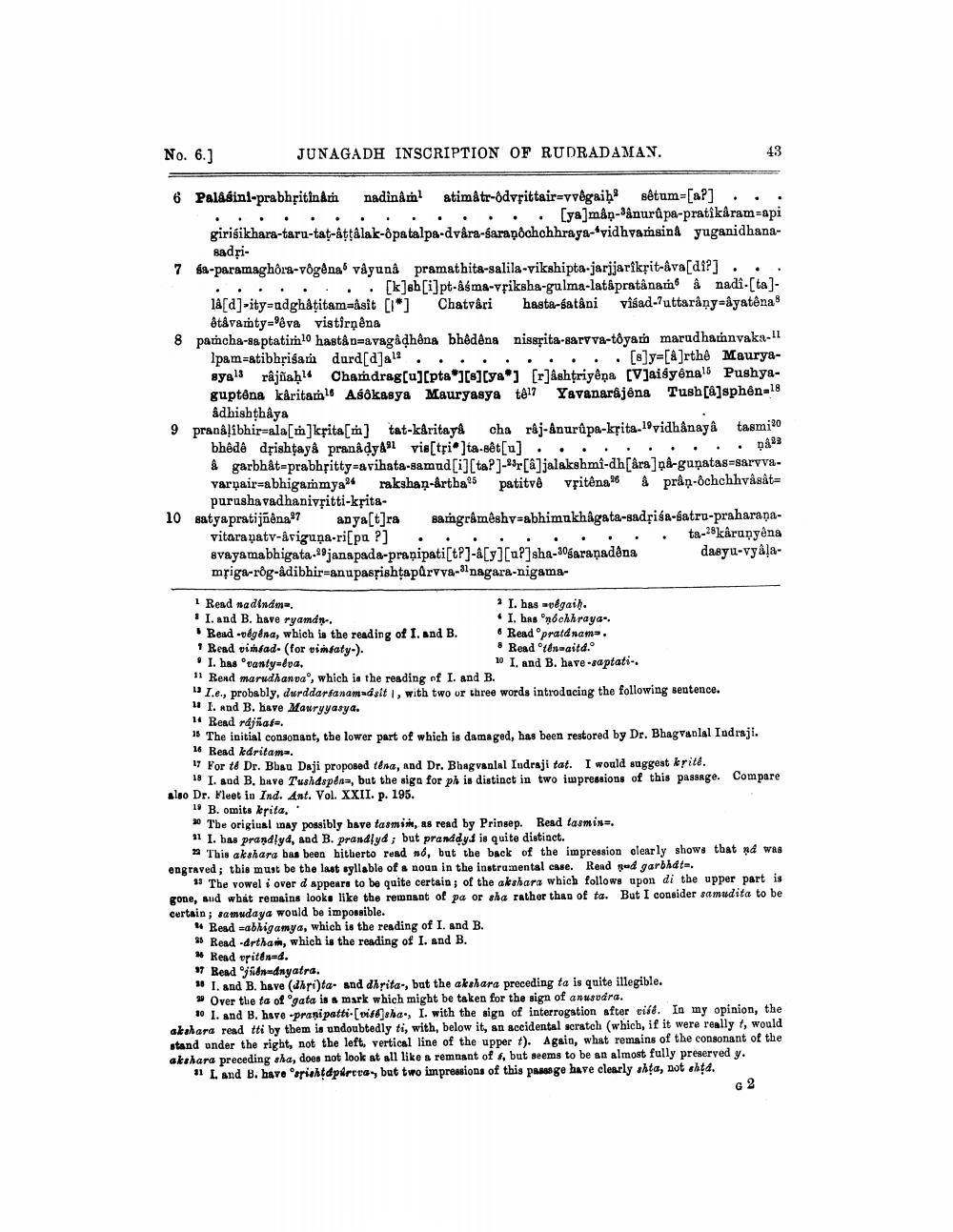________________
No. 6.]
JUNAGADH INSCRIPTION OF RUDRADAMAN.
6 Palasini-prabhfitinam nadinâminatimåtr-odvfittair=vvêgai” sêtum=[a?] ... . . . . . . . .
. . . . Cya]man-nurûpa-pratikaram-api girisikhara-taru-tat-áttálak-patalpa-dvåra-saraņôchchhraya-*vidhvamsind yuganidhana
Badri7 sa-paramaghôra-vôgêna vâyunâ pramathita-salila-vikshipta-jarjjariksit-ava[di?] ...
. . . . . . . [k]eb[i]pt-agma-vriksha-gulma-latåpratânam à nadi.(ta)14[a]-ity=adgháțitamaksit [1] Chatrâri hasta-satâni visad-uttarany=yatêna
êtêvamty='éva vistirņêna 8 parcha-na ptatim10 hast&peavagadhôna bhêdêna nisspita-sarv va-toyat marudhanvaka-11
Ipamratibhrišam dard[d]al? . .. .. .. ... [6]y=[&]rthê Mauryasyal rajñaḥ Chamdrag[u][pta ][8][ys] [r]áshtriyêņa [V]aisyênal Pushyaguptôna kåritam Asokasya Mauryasya tê? Yavanarajéna Tush[@]sphen-18
adhishthaya 9 prankļibhir-ala[m]krita[m] tat-kåritay& cha råj-Anurûpa-krita-19 vidhånayê tasmilo bhêdê dộishtay& prank dyAl vis[tri"]ta-set[u] .
. PAR * garbhât=prabhşitty-avihata-samud[i][ta?]-3r[a]jalakshmi-dh[Ara]ņ&-gunatas-sarvvavarpair=abhigarmya rakshan-&rtha patitve vritena & prân-êchchhvâsât=
purusha vadhanivșitti-krita10 satyapratijnena7 anya[t]ra samgråmêshy=abhimukhâgata-sadpisa-satro-praharanavitaraṇatv-åriguņa-rispa ?] . : : : . . .
ta-28kârungêna svayamabhigata-ojanapada-prasipati[t?]-[y][DP]sha-30garaṇadena d asyu-vyâļampiga-rôg-adibhir=an upassishtapärvva-nagara-nigama
1 Read nadindm.
* I. has vegaih. " I. and B. have ryaman..
• I. has nochhraya. . Read -végéna, which is the reading of I. and B. • Readprald nama. * Read vinfad. (for vinsaty-).
* Read on-aita. • I. has oranty-dva.
10 I. and B. have-saptati. 11 Read marudhanpao, which is the reading of I. and B.
I.e., probably, durddarfanamadsit I, with two or three words introducing the following sentence. 11 I. and B. have Mauryyasya. 1. Read rdjias. * The initial consonant, the lower part of which is damaged, has been restored by Dr. Bhagvanlal Indraji. 16 Read kdritama. 17 For td Dr. Bhau Daji proposed tena, and Dr. Bhagvanlal Indraji tat. I would suggest kritt.
" I and B. have Tushdspåna, but the siga for ph is distinct in two impressions of this passage. Compare also Dr. Kleet in Ind. Ant. Vol. XXII. p. 195.
19 B. omits krita, #0 Tbe origiual inay possibly have tasmist, as read by Prinsep. Read lasmina. 11 I. bas prandlyd, and B. Prandlyd ; but pranády is quite distinct.
- This akshara has been hitberto read no, but the back of the impression clearly shows that nd was engraved; this must be the last syllable of a noun in the instrumental case. Read Bed garbhdt.
The vowel i over d appears to be quite certain; of the akshara which follows upon di the upper part is gone, and what remains looks like the remnant of pa or tha rather than of ta. But I consider samudita to be certain; samudaya would be impossible.
* Bead wabhigamya, which is the reading of I. and B. * Read -drthan, which is the reading of I. and B. * Read vrites=d. 97 Read jridx=dnyatra. # Iand B. have (dhrů)ta. and drita., but the akshara preceding ta is quite illegible. » Over the ta of gata is a mark which might be taken for the sign of anusudra.
10 I. and B. have pranipatti [wifeha, I with the sign of interrogation aftor više. In my opinion, the akalara read tti by them is undoubtedly ti, with, below it, an accidental scratch (which, if it were really 1, would stand under the right, not the left, vertical line of the upper t). Again, what remains of the consonant of the akadara preceding sha, does not look at all like a remnant off, but seems to be an almost fully preserved y. 11 L and B. havessiahtdpirora, but two impressions of this page have clearly shta, not shtd.
G 2




